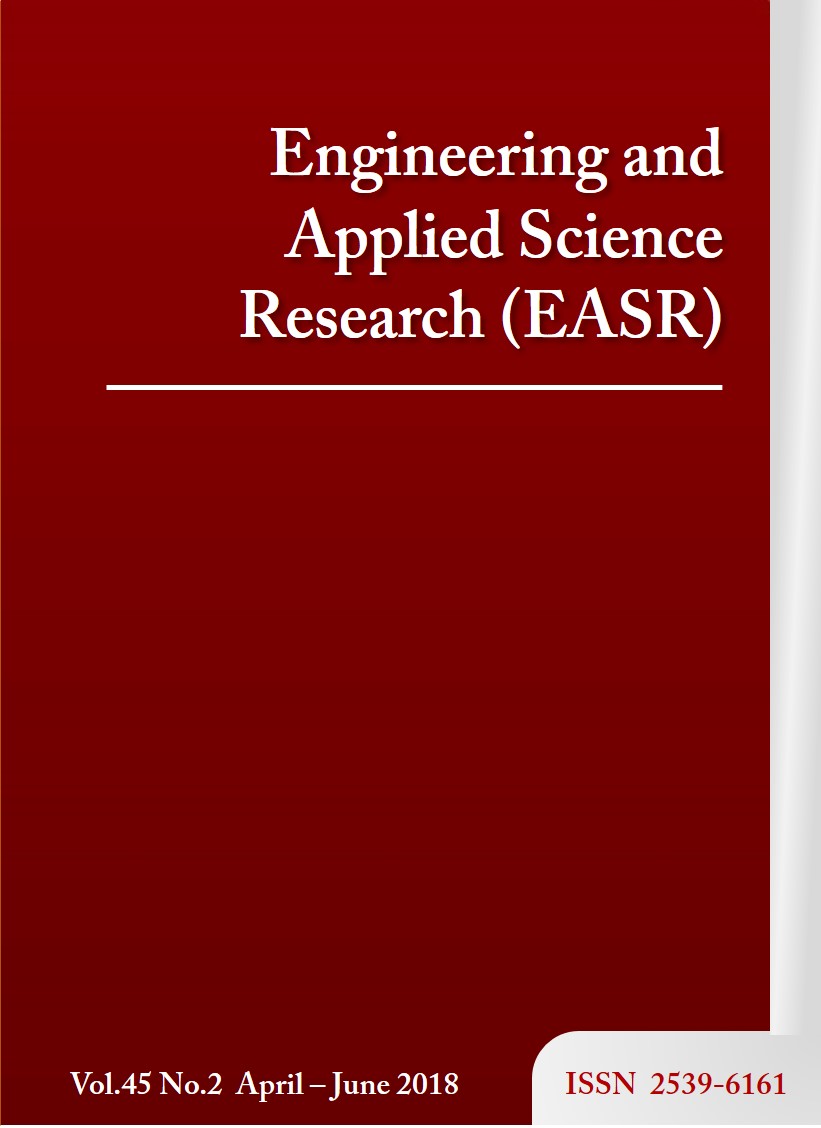Combining accelerometry-based motion artifact cancellation with pulse oximetry processing
Main Article Content
Abstract
This paper proposes a combination of motion artifact (MA) cancellation with pulse oximetry processing. The objectives were to develop motion-resistant pulse oximetry processing relying on using accelerometry-based MA cancellation, and to explore the performance of the proposed processing method in providing arterial oxygen saturation () when the red and infrared (IR) photoplethysmogram (PPG) were corrupted by a MA. A PPG acquisition system was designed and constructed in the laboratory for the experiments. A three-axis accelerometer was utilized to detect the motion of a finger probe. An acceleration signal corresponding to the longitudinal direction of the finger was used to generate a motion reference signal for active noise cancellation using an adaptive filter. A Savitzky-Golay filter was applied to obtain the normalized first derivative of red and IR PPGs, and to generate a motion reference signal. The MA was eliminated from the normalized first derivative of red and IR PPGs using an adaptive filter, of which the adaptive algorithm was a recursive least square (RLS) method. The appropriate filter order was 16. After the MA cancellation, the normalized first derivative of the red and IR PPGs were expected to be free of MA, and they represented the arterial light absorption. The ratio of red to IR absorption () was computed and converted to the using the saturation equation obtained from the calibration. The experimental results showed that the theoretical concept for combining the accelerometry-based MA cancellation with the pulse oximetry processing was practical. The proposed processing method helped reduce the error of the measurement when a MA was present, and it had more resistance to MA than conventional pulse oximetry processing.
Article Details
This work is licensed under a Creative Commons Attribution-NonCommercial-NoDerivatives 4.0 International License.
References
Petterson MT, Begnoche VL, Graybeal JM. The effect of motion on pulse oximetry and its clinical significance. Anesthesia and analgesia. 2007;105(6 Suppl):S78-84.
Ram MR, Madhav KV, Krishna EH, Komalla NR, Reddy KA. A Novel Approach for Motion Artifact Reduction in PPG Signals Based on AS-LMS Adaptive Filter. IEEE Transactions on Instrumentation and Measurement. 2012;61(5):1445-57.
Peng F, Zhang Z, Gou X, Liu H, Wang W. Motion artifact removal from photoplethysmographic signals by combining temporally constrained independent component analysis and adaptive filter. Biomedical engineering online. 2014;13:50.
. Yousefi R, Nourani M, Ostadabbas S, Panahi I. A Motion-Tolerant Adaptive Algorithm for Wearable Photoplethysmographic Biosensors. IEEE Journal of Biomedical and Health Informatics. 2014;18(2):670-81.
Asada HH, Hong-Hui J, Gibbs P, editors. Active noise cancellation using MEMS accelerometers for motion-tolerant wearable bio-sensors. The 26th Annual International Conference of the IEEE Engineering in Medicine and Biology Society; 2004 1-5 Sept. 2004.
Gibbs P, Asada HH, editors. Reducing motion artifact in wearable bio-sensors using MEMS accelerometers for active noise cancellation. Proceedings of the 2005, American Control Conference, 2005; 2005 8-10 June 2005.
Wood LB, Asada HH, editors. Noise Cancellation Model Validation for Reduced Motion Artifact Wearable PPG Sensors Using MEMS Accelerometers. 2006 International Conference of the IEEE Engineering in Medicine and Biology Society; 2006 Aug. 30 2006-Sept. 3 2006.
Comtois G, Mendelson Y, Ramuka P. A comparative evaluation of adaptive noise cancellation algorithms for minimizing motion artifacts in a forehead-mounted wearable pulse oximeter. Conference proceedings : Annual International Conference of the IEEE Engineering in Medicine and Biology Society IEEE Engineering in Medicine and Biology Society Annual Conference. 2007;2007:1528-31.
Schafer RW. What is a Savitzky-Golay filter? [Lecture Notes]. IEEE Signal Processing Magazine. 2011;28(4):111-7.
Relente AR, Sison LG, editors. Characterization and adaptive filtering of motion artifacts in pulse oximetry using accelerometers. Proceedings of the Second Joint 24th Annual Conference and the Annual Fall Meeting of the Biomedical Engineering Society. Engineering in Medicine and Biology; 2002.
Wieben O. Light Absorbance in Pulse Oximetry. In: Webster JG, editor. Design of Pulse Oximeters: Institute of Physics Publishing; 1997.
Bland JM, Altman DG. Statistical methods for assessing agreement between two methods of clinical measurement. Lancet (London, England). 1986;1(8476):307-10.
Tungjitkusolmun S. Accuracy and Errors. In: Webster JG, editor. Design of Pulse Oximeters: Institute of Physics Publishing; 1997.



